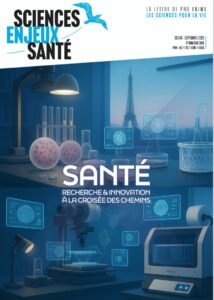
New risk assessment strategies with NAM, The NAM Navigator, 3D Bone Marrow Niche In Vitro Models, Digitalized organoids and more
News on non-animal methods
MAY 19 - 23, 2025NEWS, REPORTS & POSITION STATEMENTS
1. Infant with rare, incurable disease is first to successfully receive personalized gene therapy treatment
In a groundbreaking advance for individualized medicine, an infant diagnosed with carbamoyl phosphate synthetase 1 (CPS1) deficiency— a rare and often fatal metabolic disorder — has become the first patient to receive a gene therapy customized to their unique genetic mutation. A team of researchers at the Children’s Hospital of Philadelphia (CHOP) and the Perelman School of Medicine at the University of Pennsylvania developed the therapy using CRISPR gene-editing technology.
“As a platform, gene editing — built on reusable components and rapid customization — promises a new era of precision medicine for hundreds of rare diseases, bringing life-changing therapies to patients when timing matters most : Early, fast, and tailored to the individual” said Joni L. Rutter, Ph.D., Director of NIH’s National Center for Advancing Translational Sciences (NCATS).
2. NAMazing : Déjà Vu at the lab bench — Why animal-free science is the new automobile
The ongoing technological shift in life sciences — from traditional animal testing to microphysiological systems (MPS) and artificial intelligence (AI) — remarkably mirrors the historic transition from horse-drawn carriages to automobiles over a century ago. History may not repeat itself exactly, but it certainly rhymes, particularly when groundbreaking innovations challenge established norms.
Just as automobiles became synonymous with modernity, mobility, and efficiency, animal-free technologies promise to define a new era of humane, precise, and ethically responsible biomedical research. Dive into the interesting and fresh analysis by Professor Thomas Hartung.
3. Science-driven and animal-free safety assessments : New AFSA’s position paper
Despite REACH’s “last resort” rule, outdated animal tests are still routinely ‘required’, even when modern, animal-free methods are available, scientifically valid and required to be used when available. In a new position paper, AFSA (Animal-Free Safety Assessment) examines Difficult, Impossible, and Meaningless (DIM) testing : situations where animal tests are technically unfeasible or scientifically unjustified, yet still requested due to regulatory rigidity and a “tick-box” mindset that is part of the REACH legislation.
Annex XI of REACH was intended to enable waivers and support tailored, animal-free methods. However, unclear guidance and inconsistent interpretation often prevent its effective use. With the upcoming REACH revision, now is the time to move beyond box-ticking and ensure safety assessments are truly science-driven and animal-free.
4. Application of NAM for nonclinical safety assessment of drug candidates
A group of toxicologists from 11 pharmaceutical companies have collected studies from recent projects in which animal models alone proved to be limited or inadequate for safety testing. In a new review, a safety reflection initiative subgroup of the European Federation of Pharmaceutical Industries and Associations (EFPIA) / Preclinical Development Expert Group (PDEG) developed four categories of drug candidates for which alternative in vitro approaches are applicable and discussed progress in using in vitro testing solutions for safety assessment in these categories.
The article highlights new risk assessment strategies, initiatives and consortia promoting the advancement of NAMs. This collective work is meant to encourage the use of NAMs for more human-relevant safety assessment, which should ultimately result in reduced animal testing for drug development.
INTERVIEWS, NOMINATIONS & AWARDS
5. Prioritizing human-based technologies : The commitment of newly appointed NIH Director, Dr. Jay Bhattacharya
In a recent interview on Fox News, newly appointed NIH Director, Dr. Jay Bhattacharya reflected on his landmark commitment to prioritize human-based technologies in biomedical research. “It’s very easy, for instance, to cure Alzheimer’s in mice. But those things don’t translate to humans.”
Watch the interview shared on Linkedin
TOOLS, PLATFORMS, CALLS
6. The NAM Navigator : a repository on validation and acceptance of NAM
Many NAMs (New Approach Methodologies) have been developed over recent years, but their large-scale usage by industry and pharma still stays behind. That is because broad adoption of a new method requires more than just its development and publication in a scientific journal. It also entails standardization and validation of the NAM, by testing the robustness and reproducibility of the underlying protocol.
ZonMw launches the NAM Navigator : a knowledge portal to navigate you through information on the development, standardization, validation and acceptance of NAMs. It acts as an online guide providing specific information needed in each of these steps, thereby increasing the broad use of animal-free innovations.
7. ValNAM : Validating and implementing NAM in a regulatory context
This call for proposals aims to validate existing animal-free innovations in a regulatory context and is intended for consortia consisting of at least one Dutch and one German organisation, of which at least one public organisation and one commercial company.
In this call, ZonMw wants to fund the Dutch partner(s) of four to eight research projects, each with an amount of K€ 300 – 600 for the Dutch part of the budget. ZonMw will not fund more than a total of M€ 2.5. Deadline : 26 May 2025, 11.59 PM.
Read more about the call and apply
8. Crown Bioscience Unveils 3D Bone Marrow Niche In Vitro Models
At the 2025 Annual Meeting of the American Association for Cancer Research (AACR) — a major international conference focused on cancer science and therapeutic development—Crown Bioscience, a preclinical contract research organization specializing in oncology and immuno-oncology, announced the launch of its 3D Bone Marrow Niche (BMN) platform.
Crown’s BMN platform is designed to more closely reflect this native architecture by incorporating key bone marrow components (stromal cells, endothelial cells, and mesenchymal-endothelial networks) within biofunctional hydrogel scaffolds.
“Crown Bioscience is proud to unveil this high-content imaging-based 3D BMN platform that offers a unique and robust high-throughput drug screening in primary patient cells that allows testing of malignancies and toxicities at scale,” said Ludovic Bourré, Vice President, Research and Innovation, Crown Bioscience.
Read the release on Crown Bioscience
INDUSTRY, BIOTECH & PARTNERSHIPS
9. Tempus, AstraZeneca, and Pathos Partner to Build Oncology Foundation Model Using Multimodal Data
Tempushas announced new multi-year agreements with AstraZeneca and Pathos AI to co-develop what is described as the largest multimodal foundation model in oncology.
The model will be trained on Tempus’ de-identified oncology datasets and is intended to support research across biological insight generation, target discovery, and therapeutic development. All three partners will have access to the resulting model for use in their respective R&D efforts. The deal includes $200 million in combined fees for data licensing and model development.
SCIENTIFIC DISCOVERIES & PROTOCOLS
10. Digitalized organoids : integrated pipeline for high-speed 3D analysis of organoid structures using multilevel segmentation and cellular topology
Organoids replicate tissue architecture and function and offer a unique opportunity to explore the impact of external perturbations in vitro. However, conducting large-scale screening procedures to investigate the effects of various stresses on cellular morphology and topology in these systems poses important challenges.
In this study, researchers introduced an AI-based multilevel segmentation and cellular topology pipeline for screening morphology and topology modifications in 3D cell culture at both the nuclear and cytoplasmic levels, as well as at the whole-organoid scale. Offering a user-friendly interface named 3DCellScope and a comprehensive set of tools for discovery-like assays in screening 3D organoid models, they demonstrate the versatility of their approach through proof-of-concept experiments, encompassing well-characterized conditions and poorly explored mechanical stressors such as microgravity.
Read the publication in Nature Methods
11. Increasing complexity of tissue models with spatiotemporal tissue patterning in organ-on-a-chip systems
Spatial heterogeneity plays a key role in the development and function of human tissues and therefore needs to be incorporated within in vitro models to maximise physiological relevance and predictive power. Bioengineers at Queen Mary University of London have taken a significant step forward.
In their latest research, published in the Journal of Tissue Engineering, the team describes how they developed and optimised methods to generate spatial heterogeneity of hydrogel-embedded bioactive signalling molecules within organ-on-a-chip (OOC) systems to drive spatiotemporal tissue patterning through controlled stem cell differentiation. The application of hydrogel-embedded morphogens to drive spatial tissue patterning within OOC systems has broad-ranging applicability for a diverse range of tissues and organs, and a wide variety of OOC platforms.
Read the publication in the Journal of Tissue Engineering


